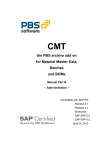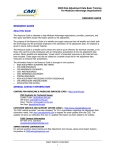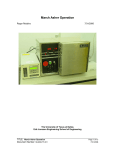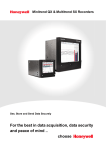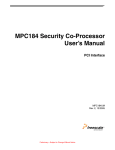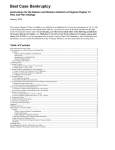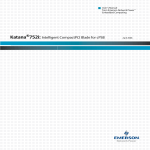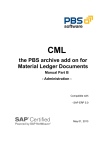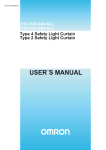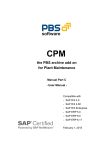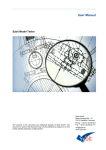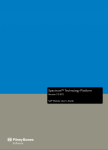Download PBS archive add on CPS - Manual Part B
Transcript
PBS archive add on CPS Project Systems Manual Part B - Administration - Compatible with SAP ERP 2004 September 12, 2013 © 2003 - 2013 PBS Software GmbH Schwanheimer Straße 144a 64625 Bensheim Phone: +49 - 6251 - 174 0 Fax: +49 - 6251 - 174 174 eMail: [email protected] Internet: www.pbs-software.com PBS archive add ons® is a registered trademark of PBS Software GmbH, Ben-sheim. SAP, R/3, SAP, ERP, SAP NetWeaver, ABAP are registered trademarks of SAP AG, Walldorf/Baden Acrobat Reader is a registered trademark of Adobe Systems Incorporated. 2 Introduction to the PBS ILM Concept Information Lifecycle Management Information Lifecycle Management (ILM) means the administration of information related to the time when it is used, taking into account its total costs and compliance. A conclusive, efficient ILM concept must, as a result, control data growth, manage retention rules, and also ensure compliant data storage. Furthermore, an easy access to archived data is decisive and, for example, its transfer during internal and external audits. PBS ILM Concept PBS software provides existing SAP customers extensive solutions to put into practice the requirements that were described above for a stringent and successful ILM concept. PBS is considered as an expert for complex, integrated data accesses to archived and database data and meanwhile, also to data that is located on decommissioned SAP systems. In addition to classical SAP data archiving, SAP BI-specific nearline storage is also supported. PBS archive add ons® PBS archive add ons always rely on SAP archiving having been carried out successfully. This is the basis for a permanently high-performing SAP system. In principle, you can indeed retain posted documents in the SAP database for a very long time due to a large database capacity. Depending on the document volume, this may result, however, in massive performance losses and, sooner or later, heavily increasing operation costs. The daily backup becomes difficult for large data stocks, for example. A convenient display and evaluation of archived transaction data – as the SAP user is used to for database data – can often only be carried out in a very restricted manner using SAP standard means depending on the application module. This is particularly the case for large archive data stocks. The PBS archive add ons can be used here. They can be provided for nearly all SAP modules and release levels, and start with a "C" (for Complete) in their description. For example, PBS archive add on CCOPA for the SAP module COPA. Using the PBS archive add ons you can quickly and easily access your archived data even after data archiving during your day-to-day business. The unrestricted data access is realized by an intelligent indexing concept. It extends the SAP archive infrastructure components and integrates itself optimally with SAP archiving. Archive data that has been indexed can still be provided after a release upgrade immediately, without restrictions, and without migration effort. The PBS archive index is stored in sequential files of the SAP file system in the same way as the SAP archive data. Afterwards, you can access the archive data online via the familiar transactions. The SAP user can display the data from the SAP database and the archive data simultaneously via the PBS archive add on index. For the user, it seems as though the archived data is still in the SAP database. The deep integration of the PBS transactions also enables direct navigation to subsequent and previous documents both within the indexed SAP module as well as to linked documents from other SAP modules. This applies not only for resident but also without restrictions for archived data. The benefit for the user increases the more PBS archive add ons are used. The potential benefits of the ILM concept raises substantially if you take into account the savings that result from the SAP mirror systems. There are usually at least two of them meaning that the saved disk storage can be tripled by performing data archiving. Thus, time is saved for the data backup. 3 Table of Contents 1. Introduction 5 2. Overview of the PBS archive add on CPS 6 2.1. Supplied Menus 6 2.2. Basic Information on the PBS archive add on CPS 8 3. Setup of the PBS archive add on CPS 12 3.1. Procedure 12 3.2. Navigation to the Index Generation Programs 15 3.3. Index Generation 18 3.3.1 Initial Index Generation (Initial Setup) 20 3.3.2 Activate Index 23 3.3.3 Further Index Generations (Merge Runs) 26 3.3.4 Delete SAP Archiving Runs from the Main Index 27 3.4. Archive Tool 28 3.4.1 Output of Index Information 28 3.4.2 Display Log 28 3.4.3 Scan Index Objects 29 3.5. Long-term Archive 31 3.6. Delete Archive 32 3.7. Disk Space Requirement 32 3.8. Definition of the Path to the PBS archive add on CPS 33 4. Additional project data 34 5. Converting a Report Group 36 6. List variants 37 7. Generate Hierarchy Reports 38 8. Transactions of PBS archive add on CPS 40 4 1. Introduction The PBS archive add ons are constructed in modular form and cover the application modules FI, SD, MM, CO etc. with a special program package for exactly this application. You can easily see from the name which PBS archive add on belongs to which SAP module: CFI, CSD, CMM, CCO etc. All PBS archive add ons have in common that they can be easily installed in the SAP system via the SAP transport utilities "tp" and “SAINT”. For installation details of the PBS archive add ons please see the specific installation manual (manual part A). This administration manual was written to make construction and administration of the PBS archive add on CPS as easy as possible. At first, data archiving with transaction SARA is discussed; the second topic is the PBS index construction from the SAP archive files. The modular user manual of each PBS archive add on is composed of partial manuals: - Part A: Installation - Part B: Administration, Archive Construction and Maintenance - Part C: Application Programs / Transactions There are additional manuals for the PBS utilities: Conversion Tool, Archive Browser, Translation Tool. Should you have questions regarding the installation of the PBS archive add ons or if you have problems when installing the software please call directly the Service Hotline of PBS Software GmbH: Phone: +49 - 6251 - 174 110 Fax: +49 - 6251 - 174 174 email: [email protected] Release Compatibility The PBS archive add on CPS discussed in this manual runs with the basis programs of SAP AG, 69190 Walldorf/Baden, Germany for the SAP ERP 5.0/6.0 solution. 5 2. Overview of the PBS archive add on CPS 2.1. Supplied Menus A global menu for all products and utilities of PBS Software GmbH and a menu especially for the PBS archive add on CPS are shipped with the PBS archive add on CPS. The delivery of the module contains area menus /PBS/PBS (main menu of the PBS modules) and /PBS/CPS (functions for the PBS archive add on CPS). From these menus, you have to generate now roles which then can be integrated into the user master. You can also create a role directly from the Easy Access menu. Diagram 1: Creating your own Role You are free to choose the name of the role; the name can also be within the PBS namespace. A PBS area menu is then transferred by pressing the function key 'Transfer menus from area menus' by indicating the corresponding PBS menu name. During the transfer, the system query for the resolution of the area menu is to be answered with 'yes' The role group created this way can now be integrated in the corresponding user master. We recommend to allocate the area menu /PBS/PBS to the administrators and the special function menu /PBS/CPS to the end users in the global role. Diagram 2: Initial Screen of the Role Maintenance 6 Diagram 3: Menu of the Role Diagram 4: Assigning the Role in the User Profile 7 2.2. Basic Information on the PBS archive add on CPS The PBS archive add on CPS for Project Systems is an ABAP/4 program package that enables easy and performant display evaluation of archived project data in the SAP System. The display of archived project data is largely based on the display of the SAP database. The administrative activity of PBS archive add ons is to set up and activate the PBS index and to analyze it in the event of problems using the tools supplied. The display programs must also be generated. The structure and usage of the PBS archive add on CPS always requires successful data archiving with SAP tools and access to the archive file created using these. The status of the archive file must always be set to “accessible“. The PBS archive add on CPS uses archiving runs of the archiving object: PS_PROJECT Project System: Operative Structures The SAP archiving program is executed in transaction CN80 or SARA. Standard archiving is not described in this manual. 8 Diagram 5: Initial screen, Transaction CN80 Diagram 6: Initial screen, Transaction SARA You can determine the status of the archive files via function "Administration" (transaction CN80) or "Management" (transaction SARA) for the individual archiving runs (s. Fehler! Verweisquelle konnte nicht gefunden werden.). For correct display of documents and during reporting via the PBS archive add on CPS, the deletion run of the SAP archiving must have been carried out successfully. 9 Diagram 7: Archiving File Details 10 The SAP archiving runs are read and written in the file system of the PBS archive add ons CPS via the PBS index generation program (see installation manual). Secondary indices are created in the file system for efficient access. In case a PBS index already exists, the index generation program adds the acquisition from the SAP archive. PBS index generation program SAP Archive File Existing PBS Archive File New PBS Archive File Diagram 8: Setup of the PBS archive add on After creation, the PBS index must be activated in the SAP system. Transaction /PBS/CPSA must now be executed. The operative structures of the project system can now be displayed from the PBS archive add on CPS. Chapter 3 in this manual describes the programs for creation and activation of the PBS archive add on CPS. 11 3. Setup of the PBS archive add on CPS 3.1. Procedure In order to archive operative data of the project system, the SAP archiving tool is first used to remove the data from the SAP database Caution: Individual WBS elements or subtrees of a work breakdown structure cannot be archived. Archiving is only possible for the whole structure of a work breakdown structure (including project definition). The tool is called up using transaction SARA. The archiving is object-oriented. PS_PROJECT is the archiving object for operative structures. Before archiving a variant must be created. This defines the scope of the data to be archived and several settings for the process of the archiving. Diagram 9: Calling the variant maintenance of the archiving job 12 Diagram 10: Maintain Variant of the Archiving Job The archived data is written to sequential files outside the database by the SAP archiving program. A complete archiving run is only generated if the option "Delete from database" is set. Otherwise archives are created, but the data remains in the database. 13 Diagram 11: Overview PS_PROJECT Archiving Sessions The reorganized data can no longer be displayed comfortable by standard transactions. The reduced load on the SAP database can be measured using the PBS Database Analyzer Plus. The generated SAP archives are written to the PBS archive add on CPS. The index generation program reads the SAP archive files and generates secondary indices and stores them in compressed form on magnetic disks outside the database. The archived project data are thus available for online processing and can be evaluated easily using the PBS transactions and PBS reports. The functionality of the PBS transactions and PBS reports corresponds to that of the SAP transactions and SAP reports, but they are able to read and display both data that is resident in the SAP database as well as archived data from the PBS archive add on CPS. Since the data that is located in the PBS archive add on CPS can no longer be changed, a regular data backup of the archive is not necessary. The SAP archive file that is generated during the next reorganization of the database can be added to the existing PBS archive add on CPS using the index generation program. 14 3.2. Navigation to the Index Generation Programs From SAP Release ECC 5.0 administration and archive data indexing have been bundled in the PBS Administration Board (transaction /PBS/ABO). The PBS Administration Board is the central administration instrument for the indices that are generated via the ADK technique and that were stored in so-called archiving runs (index areas). Administration and archive data indexing can be executed centrally here from an interface. The call up can also be executed directly using the transaction /PBS/CPS_ABO. Diagram 12: Navigation Adminstration Board You can also access the Administration Board via the CPS menu. Diagram 13: Navigation CPS Menu The Administration Board CPS (transaction /PBS/CPS_ABO) is called automatically instead of /PBS/CPSL and /PBS/CPSA. The initial screen of the Administration Board CPS is shown below. 15 Diagram 14: Administration Board CPS: Main index Diagram 15: Administration Board CPS: inactive indices 16 Description of the individual icons: You can use this function to move an index area from the main index into the long-term index or vice-versa. The index area is available within the main index for further merging and consolidation. The index area is not automatically made available as a long-term index for further processing for index generation. By activating an index area the indices are made available to the user. Only deactivated index areas can be activated. Deactivation of an index area means that these indices are no longer available to the user. The deletion of an index area results in all dependent table contents and physical files being deleted. In the index area information you can see for active indices which SAP archive files were indexed. For inactive indices, the index in which a merge has taken place will be specified. The log of the run provides information about the number of processed indices, the runtime and the selection criteria. Calling up the archive tool! The program /PBS/CPS_SCAN can be used to display the content of a selected index area. Starting the Index Generation Program! With index generation it is possible to index ADK files from the archiving object PS_PROJECT. The indices are also stored in ADK files. The archiving object used for this is /PBS/CPS. Help! 17 3.3. Index Generation The PBS archive add on CPS enables to keep archived project data from the SAP system available. For this, you create the PBS archive add on with the index generation program (Transaction /PBS/CPSL) from the SAP archive files. Please see the selection screen of the index generation program with its delimitations as follows: Diagram 16: Selection Screen Index Generation Program 18 Parameters Select manually: Using this option, the SAP archive files that are currently available and have been created on or after the date entered can be selected by pressing the button “SAP archive”. Now choose the SAP archive file that you wish to use for indexing with the PBS archive add on CPS. If SAP archives that have already been indexed using the main index are selected, the program rejects processing. Select automatically: If this option is selected, all available SAP archive files that have been created after the date specified are processed automatically. It is also checked here if the SAP archive has already been indexed by the main index. Delete from main index: Using this option, a list of the SAP archive files that are currently stored in the PBS archive add on CPS is displayed when you press the button “Run”. In this list, the runs that are to be deleted from the PBS archive add on CPS main index can be selected. Merge new CPS archive with active CPS archive Using this option, the new CPS archive will be merged with the currently active CPS archive. If no CPS index is active, the new index is created without a merge. Merge new CPS archive with last CPS archive If this option is selected, the new CPS archive will be merged with the last CPS archive. The last archive will be defined via table ADMI_RUN. If a CPS index does not exist, the new index is created without a merge. activate newly created CPS archive The new CPS archive is activated as the main index. delete merged CPS archive from old run CPS indices that have been merged into the new archive can be deleted directly. This reduces the data volume of inactive indices. 19 3.3.1 Initial Index Generation (Initial Setup) If all necessary information has been entered in the selection screen of the load report, the selection screen can be saved as a selection variant for the initial setup of the PBS archive add on and the report can be started as a background process. Important: The PBS archive add on CPS must be set up per client. During runtime the program generates the program from the archive data of the PBS archive add on CPS. Secondary indices are thus created from the project definition, from the work breakdown structure element and the network order from the SAP archive. The first run is not merged. Important: We recommend a data backup of the created files after each setup of the PBS archive add on. However, this is not of fundamental importance, due to the restart function of the index generation program. 20 Job Log: After each run of the index generation program a statistic is displayed, similar to the following example. This statistic is also saved in the PBS archive add on CPS and can be accessed later using the function CHECK -> LOG (CTRL+F10) or the icon ministration Board. in the Ad- Diagram 17: Start of the Index Generation Program Log, initial setup Diagram 18: End of Index Generation Program Log, initial setup 21 The number of read archive files or data records from the stock are displayed with 0 at the start of the log. An archive number that should be used for merging is not indicated in "Selections" in the log. In this example the recreated index is then activated as a main index and saves a second manual step for the user. If the flag was not set, a generated index can also be activated separately. 22 3.3.2 Activate Index After the PBS archive add on CPS has been created using the index generation program, the administration table must be loaded into the SAP system. This activates the PBS archive add on CPS. The archived data can now be accessed by the read routines. From Release ECC 5.0 the index is activated via the Administration Board. The user can choose the required index from the last of inactive indices and activate it via the function EDIT -> ACTIVATE INDEX (CTRL + SHIFT + F5) or .. The inactive indices list is sorted according to creation date and index number. The index generation run that was executed last is at the top of the list. Diagram 19: Administration Board, Activating Index Two inactive index statuses exist in the list of inactive indices. Candidates for an index activation are primarily inactive indices that have not been merged and thus have the index status "inactive". They can be activated as a main index or as a long-term index. Diagram 20: Administration Board, Index Activation Due to the merge technique in the index generation program only one active main index can exist. 23 Diagram 21: Administration Board, Main Index If an index is activated as a main index from the list of inactive indices, a possible existing active main index is deactivated and then is displayed in the list of inactive indices. Data is first determined in the read routines via the main index. Indices that are activated as a long-term index also exist for the read access. You cannot, however, merge these indices. 24 Inactive indices with the index status "inactive, merged" have already been merged in another index. They are old runs that were not deleted directly after the index generation. They are thus not necessarily the best candidates for activation. You can delete merged, inactive indices using the function EDIT -> DELETE INDEX (CTRL + SHIFT + F7) or at any time. 25 3.3.3 Further Index Generations (Merge Runs) After the initial index generation a CPS archive from the last run already exists. If the next SAP archive with project data is to be added, the same process as described above applies (initial setup). You define the CPS archive to be used for merging the new run in the selection screen. The advantage of the option 'Merge new CPS archive with last CPS archive' is that it is not necessary to activate the archive between two index generation runs. Diagram 22: Merge Archive The index generation program should be started again as a batch process. A new CPS archive is set up from the selected CPS archive (stock) and the selected PS_PROJECT archives (input). Note: If the index generation terminates with the ABAP/4 runtime error message SYSTEM_NO_MORE_PAGING or EXTRACT_NO_MORE_PAGING this is due to the insufficient size of the SAP paging file. What should be done? 1. Using transaction SM04, Goto -> Memory, an overview of the usage of the roll and paging memory by the active users and their transactions is displayed. Try to use this to clarify whether it is perhaps not the current program, but one of the others that requires so much memory. Transaction ST02 also shows the memory utilization. 2. Use transaction RZ11 in the current instance profile to check both the parameters ‘rdisp/ROLL_MAXFS’ and ‘rdisp/PG_MAXFS’. The values that can be found there specify the current block sizes for the roll or page area respectively (1=block = 8 kilobytes, 1 kilobyte = 1024 bytes). 3. On the system page, compare the size of the joint partition for the roll and paging area with the values from transaction RZ11. If the converted values do not reach the size of the partition, the parameters ‘rdisp/ROLL_MAXFS’ and ‘rdisp/PG_MAXFS’ must be adapted to the value of the partition that is provided. 4. Restart your system. If the parameter was changed, the run should be repeated after the data backup of the 26 PBS archive add on has been reloaded again. We also refer you to SAP note number 14779, which provides further information on the error described above. 3.3.4 Delete SAP Archiving Runs from the Main Index If you have already carried out several generation runs and merged in the main index, and you want to delete one or more secondary indices again, you can press the button to display a list of the previous runs. You can now select and delete the SAP archiving runs from the main index of the PBS archive add on CPS. Diagram 23: Delete SAP Archives from Main Index 27 3.4. Archive Tool 3.4.1 Output of Index Information If you select the function CHECK -> INDEX INFORMATION (CTRL + F9) or the icon the run table contents is displayed giving you some information about the PS_PROJECT archiving runs that were processed by the PBS archive add on CPS. Diagram 24: PS_RPOJECT Archiving Runs for an Index of Archiving Object /PBS/CPS This information cannot be displayed for inactive indices. If the inactive index has the index status "inactive, merged", the function displays the index run in which the inactive index was merged. Diagram 25: Administration Board, Index Information for merged inactive Indices 3.4.2 Display Log You can display the logs for the active indices via the function "CHECK -> LOG (CTRL + F10) or the icon . Logs for inactive indices can only be displayed if the index has been merged. 28 3.4.3 Scan Index Objects To manage the PBS archive add on CPS you can use the function CHECK -> SCAN INDEX OBJECTS (CTRL+F11) or the icon . Active secondary indices can be displayed directly from the PBS archive add on CPS using this function. Diagram 26: Selection screen Index identifier After selecting an index and starting the function a selection list of possible index identifiers is displayed. After selecting an index identifier the objects of the secondary index are displayed in a basic list. Via the function button "Select" or a double-click on an object you can then display the indices that exist in the archive from the object. All index fields are visible in the display. 29 Diagram 27: Index in the database that refers to the archiving object /PBS/CPS Diagram 28: Secondary Indices in the Archiving Object /PBS/CPS 30 3.5. Long-term Archive To set up and to manage long-term archives, the tab 'Long-term indices' is selected in the CSD Administration Board. Diagram 29: Long-term archive Administration in the CPS Administration Board Without activating the long-term archive, the main archive is always updated. If the runtimes of the generation program are too long, or if the indices should be kept in different areas (for example, separated by year), it is possible to convert the previously updated main archive into a long-term archive via the function EDIT -> MOVE MAIN INDEX -> LONG-TERM INDEX (CTRL+SHIFT+F1) or . A long-term archive is identified by the fact that it is no longer changed. After this conversion takes place, a new main archive is started during the continuation of the creation process. The display transactions and the programming interfaces read data from both the main archive and all long-term archives. If it is necessary to further construct a long-term archive, the existing main archive must first be converted into a long-term archive. Afterwards, the required long-term archive can be deactivated and activated for the main archive. Then it can be updated further as a main archive. 31 3.6. Delete Archive Archives that are no longer needed can be deleted completely with the function EDIT -> DELETE INDEX (CTRL+SHIFT+F7) or . This means that the logs of the index generation runs that were executed previously and the created statistics are removed. We recommend that this method is used if you want to completely delete and rebuild a CPS archive. 3.7. Disk Space Requirement The PBS archive add on CPS for Project Systems is constructed in databaseindependent file systems (see chapter 3). The system administrator’s task is to reserve free storage capacity in order to construct the archive. The available disk space capacity depends on the number of projects, which should be stored in the archive. Summary of the archive setup Reorganization of the database with the SAP transaction 'SARA' for archiving object PS_PROJECT. Access of SAP archive files of archiving object PS_PROJECT via the PBS archive add on CPS using transaction /PBS/CPS_ABO. 32 3.8. Definition of the Path to the PBS archive add on CPS The PBS archive add on CPS contains an index generation program assigned to an archiving object. /PBS/CPS PBS archive add on CPS – project system operative structures Logical file names are assigned to the archiving objects via the SAP Customizing that in turn represent a physical file path. All archive files created with the generation program are stored under this path. The archiving object for the PBS archive add on CPS is delivered with the logical file name 'ARCHIVE_DATA_FILE'. If you would like to store the archive files in another path, the logical file name must be changed. The Customizing settings of the CPS archiving object can be changed via transaction SARA. Diagram 30: Customizing settings 33 4. Additional project data Orders assigned to the WBS element are additional data for the project. They are not archived with PS_PROJECT but via CO_ORDER, PM_ORDER or PP_ORDER. PS_PROJECT only writes info records for orders if the orders are still resistant in the database at the time of archiving. If assigned archived orders also need to be displayed, reference must be made using transaction /PBS/CPSN. The selection screen of the program with the selections is displayed below: Diagram 31: Load orders 34 The following archiving objects can be selected: Diagram 32: Selection list SAP archiving objects Parameters Select manually: This option allows you to select the SAP archive files that are currently available and not yet processed by pressing “SAP archive”. Select automatically: If you select this option, all available SAP archive files that were created after the specified date are processed automatically. Delete old run: If you select this option, a list of the currently processed SAP archive files of the selected archiving object in the PBS archive add on CPS is displayed when you press the button “SAP archive”. In this list, you can select the runs for which data should no longer be displayed with reference to the PS data. The reference of the PBS archive add on to the SAP archives is deleted. 35 5. Converting a Report Group Project system report groups which are based on table CCSS can be converted with transaction /PBS/CPSC. Then, you are able to read project costs from the database and/or the CPS archive. Several reports are generated during converting a report group. The names of all reports are defined by the transaction. Diagram 33: Converting a report group Diagram 34: List after converting a report group 36 6. List variants A query is made for the variant that controls the layout formatting in some transactions. This layout contains the information regarding list column structure, sort criteria and filter conditions. Diagram 35: Selection of display variant, transaction CJI3 Transactions /PBS/CPS_LVAR are used to create display variants for the transactions /PBS/CPS_CJI3, /PBS/CPS_CJI4 and /PBS/CJI5. This is carried out by copying the display variants of the original transactions. The program adds the column for the PBS indicator. Diagram 36: Copy List Variants 37 7. Generate Hierarchy Reports You can create and generate research reports with the access to archived data using the transaction /PBS/CPSB2. The generated reports are managed independently of the SAP original reports. Diagram 37: Initial Dynpro to create Hierarchy Reports 38 Description of the individual icons: Create report First select a template. This must be an SAP hierarchy report or an SAP form of the application class KP (= RK-P: Projects). The original report is copied to the PBS archive add on CPS and the generation status is set to "N". Generate report Secondly, an executable report that allows archive accesses is generated on the basis of the original report copy. The report generation status is then "G". Report and generated report are deleted from the PBS archive add on CPS. Report parameter display: Descriptive title Assigned SAP form. Own report forms are not created in the PBS archive add on CPS. Information about the generation status and the name of the generated report. Information about creation, change and usage Display of language-dependent report title in short, middle and long form. The log-on language is a standard setting. Existence check of copy for report 12KST1C in the PBS archive add on CPS. It is recommended to create the research report /PBS/12KST1C according to the details in diagram 37 because it is displayed in transaction /PBS/CN41 via "Goto -> Structure overview -> Cost report". 39 8. Transactions of PBS archive add on CPS The following table provides an overview of the transactions supplied in the PBS archive add on CPS. The display transactions are explained in detail in manual part C (Application Programs/Transactions). PBS SAP Transaction description 5.0 6.0 /PBS/CPS - Menu of the PBS archive add ons CPS X X /PBS/CPS_ABO - Administration Board CPS X X /PBS/CPSN - Load orders X X /PBS/CPSB2 - Generate Hierarchy Report X X /PBS/CPSC - Convert Report Group X X /PBS/CPS_LVAR - Copy List Variants X X Tab. 1: Transactions of the PBS archive add on CPS 40 PBS SAP Transaction description 5.0 6.0 /PBS/CJ20N CJ03 Project Builder X X /PBS/CJ03 CJ03 Display Work Breakdown Structure X X /PBS/CJ08 CJ08 Display Project Definition X X /PBS/CJ13 CJ13 Display WBS Element X X /PBS/CN23 CN23 Display Network X X /PBS/CN28 CN28 Display Network Confirmations /PBS/CJ31 CJ31 Display Project Original Budget X X /PBS/CJ41 CJ41 Display Project Plan X X /PBS/CJ43 CJ43 Display Project Revenues X X /PBS/CN41 CN41 Structure Overview X X /PBS/CN42N CN42N Overview: Project definitions X X /PBS/CN43N CN43N Overview: WBS elements X X /PBS/CN46N CN46N Overview: Networks X X X /PBS/CPS_CJIA CJIA Project Actual and Commitment Paymt LIs X X /PBS/CPS_CJI3 CJI3 Project Actual Cost Line Items X X /PBS/CPS_CJI4 CJI4 Project Plan Cost Line Items X X /PBS/CJI5 CJI5 Project Commitment Line Items X X /PBS/CJI8 CJI8 Project Budget Line Items X /PBS/CJI9 CJI9 Project Struct.Pld Costs Line Items X PBS/CJE0 CJE0 Execute Hierarchy Reports X X /PBS/CJEB CJEB Background Processing, Hierarchy Report X X /PBS/CJEY CJEY Reorganize Report Data /PBS/CPSE GR55 Execute Report Group X X X Tab. 2: Transactions of the PBS archive add on CPS 41











































